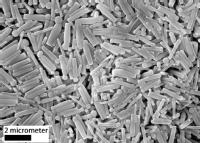News Library
Sébastien Perrier Group reports Janus nanotubes in Nature Communications
A new family of organic nanotubes was reported in a recent article in Nature Communications. The group of Sébastien Perrier, in collaboration with Professor Kate Jolliffe at the University of Sydney, have designed cyclic peptide / polymer conjugates that can assemble into tubular structures based on the stacking of the cyclic peptides, and provide a tube with a sub-nm internal diameter. Attached to each of the cyclic peptides are two different types of polymers, which tend to de-mix and form a shell for the tube with two faces, and form Janus nanotubes (after the Roman god Janus who is usually depicted as having two faces, since he looks to the future and the past).
Two new Centres for Doctoral Training
Warwick Chemistry has played a lead role in securing funding from the Engineering and Physical Sciences Research Council for 2 new Centres for Doctoral training, in Molecular Analytical Science and Diamond Science and Technology, as part of the recently announced UK's largest investment in postgraduate training in engineering and physical sciences. The Universities and Science Minister, David Willetts, announced the funding of over seventy new Centres for Doctoral Training (CDTs), spread across 24 UK universities on 22nd November.
For further information please visit:
http://onlinepressoffice.tnrcommunications.co.uk/universities-funding/video

Alcoholic drinks perfect solvents for polymerisation
International researchers have gone through the contents of their liquor cabinets to see if alcoholic drinks make good solvents for single-electron transfer living radical polymerisation (SET-LRP). And the answer is an unequivocal yes!
Motorised microscopic matchsticks move in water with sense of direction
The @BonLab at the University of Warwick has devised a new powerful and very versatile way of controlling the speed and direction of motion of microscopic structures in water using what they have dubbed chemically ‘motorised microscopic matchsticks’.

Before now most research seeking to influence the direction of motion of microscopic components have had to use outside influences such as a magnetic field or the application of light. The University of Warwick team have now found a way to do it by simply adding a chemical in a specific spot and then watching the microscopic matchstick particles move towards it, a phenomenon known as chemotaxis.
The research published in the journal Materials Horizons (RSC) in a paper entitled Chemotaxis of catalytic silica–manganese oxide “matchstick” particles 
 found that by adding a small amount of a catalyst to the head of a set microscopic rods, they could then cause the rods to be propelled towards the location of an appropriate ‘chemical fuel’ that was then added to a mixture.
found that by adding a small amount of a catalyst to the head of a set microscopic rods, they could then cause the rods to be propelled towards the location of an appropriate ‘chemical fuel’ that was then added to a mixture.
For the purposes of this experiment the researchers placed silica–manganese oxide ‘heads’ on the matchstick material and introduced hydrogen peroxide as the chemical fuel in one particular place.
They placed the ‘matchsticks’ in a mixture alongside ordinary polymer microspheres.
When the hydrogen peroxide was added the microspheres continued to move in the direction of convection currents or under Brownian motion but the matchsticks were clearly rapidly propelled towards the chemical gradient where the hydrogen peroxide could be found.
The reaction was so strong that more than half of the matchstick particles did not reverse their orientation once over their 90 seconds of travel towards the hydrogen peroxide – even though they were contending with significant convection and Brownian rotation.


University of Warwick research chemical engineer Dr Stefan Bon
 who led the research said:
who led the research said:
“We choose high aspect ratio rod-like particles as they are a favourable geometry for chemotactic swimmers, as seen for example in nature in the shapes of certain motile organisms”
“We placed the ‘engine’ that drives the self-propulsion as a matchstick head on the rods because having the engine in the ‘head’ of the rod helps us align the rod along the direction of travel, would also show the asymmetry perpendicular to the direction of self-propulsion, and at the same time it maintains rotational symmetry parallel to the plane of motion.
“Our approach is very versatile and should allow for future fabrication of micro-components of added complexity.
“The ability to direct motion of these colloidal structures can form a platform for advances in supracolloidal science, the self-assembly of small objects.
“It may even provide some insight into how rod shapes were selected for self-propelled microscopic shapes in the natural world.”
Notes for editors:
Dr Stefan Bon can be contacted on S.Bon@warwick.ac.ukor +44 (0)2476 574009 or + 44 (0)7736932205
Or you can contact Anna Blackaby, University of Warwick press officer, on +44 (0)2476 575910 or +44 (0) 7785 433155 ora.blackaby@warwick.ac.uk
The research has just been published in the journal “Materials Horizons” in a paper entitled Chemotaxis of catalytic silica–manganese oxide “matchstick” particles DOI: 10.1039/c3mh00003f

The authors wish to thank Peter W. Dunne, David Burnett, and Luke A. Rochford for help with XRD analysis. We thank EPSRC, Chemistry Innovation, and AkzoNobel for funding (ARM). Some of the equipment used was funded by West Midlands AM2 Science City initiative.
